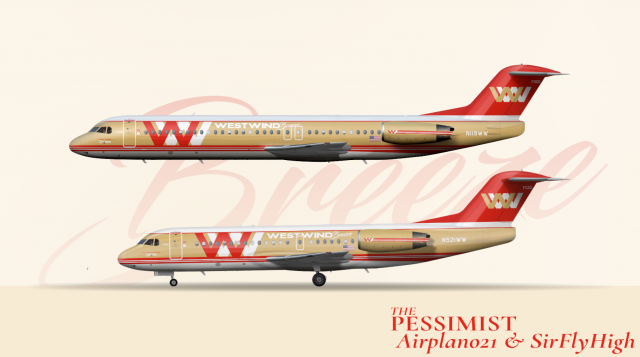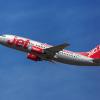
1988 - Fokker 100 and Fokker 70 Breeze Editions
- Owner: ThePessimist (View all images and albums)
- Uploaded: Jun 03 2023 04:19 PM
- Views: 2,155
- Album Westwind

One of many challenges that faced Westwind was the slow decline of its once flagship commuter services between San Francisco, San Diego, and Phoenix. Since the early 1950s, Westwind had served this corridor of service between its so called triple crown cities with nearly hourly flights. First with a hodge podge of aircraft, then Lockheed L188s, and by the 70s a platoon of tired 727-200s. These flights remained profitable for the carrier for many years by virtue of a lack of competition on the routes. However, this stability made SFO, SAN, and PHX targets for upstart low-cost airlines operating in a post deregulation era. By 1983, consumers were awash with choices on the route and there was very little reason to chose Westwind’s services provided by nearly prehistoric 727s. Services came to a breaking point that year and everyone except for Westwind management seemed to know something had to be done. On a Thursday in late October of that year, a reporting team from the San Diego Advertiser boarded WW107 for the 3:30 flight from San Diego to Phoenix and were shocked to find that the three of them were the only passengers on the flight. That Friday, the Advertiser put the story of Westwind’s ghost flights on the front page with the headline “Experience Private Jet Service for the Price of a Westwind Economy Fare”. Whilst assurances to stockholders that Westwind’s backbone was in good condition had been enough to hold off significant scrutiny, the headline story in San Diego’s dominant newspaper made it impossible to ignore the money being thrown away to maintain hourly services between Westwind’s triple crown cities. Management that had refused to make changes despite some flights running completely empty was forced to revaluate or leave the company.
Westwind management was not going to give up on the triple crown city services without a fight though. They came up with what they viewed as a novel idea. The 727-200s were not only old but also cavernous. Filling them on hourly services had never been easy even before there was competition on the routes. When the 722s had first been assigned to the routes it had been an entirely logical move as Electras were phased out of all short haul services. Since the last Electra had been retired in 1974, no one had asked why the 722s operated triple crown flights with increasing losses. Westwind operated a smaller class of aircraft in its Fokker 28s but those were small jets for short hops and small airports. The F28s were significantly smaller than the 722s which could solve the oversupply problems on the triple crown routes. Their small size would also make it cheaper to retrofit the aircraft with new interiors that would help services better compete with swanky non-traditional carriers. Further, freeing up 722s would allow Westwind to supplement capacity at its new Cincinnati outpost. Finally, the move could be made in tandem with the inauguration of contract services under the West Express brand so that other smaller airlines would take over routes formerly served by F28s. Moving the F28s to cover services between SFO, SAN, and PHX was a win win win move. Westwind had not done it because they had not even considered the possibility of using smaller planes to server larger cities. However, the article in the Advertiser spurred the change that should have been made two years before. Westwind developed the Breeze sub-brand for its frequent connecter services between the triple crown cities and upgraded the interiors on several of its F28s to include modern amenities like an electronic based in-seat audio system: the first installed on American narrowbody aircraft. The Breeze sub-brand was meant to be a subtle calling card and so these original F-28s wore the airline’s standard livery with the addition of Breeze titles.
However, management had bigger plans for Breeze than just an upgrade of older Fokker Fellowship type aircraft. In 1983, Fokker announced a modern version of its jet aircraft and Westwind, impressed by the versatility and longevity of its existing Fokker aircraft, was immediately intrigued. The F100 and later F70 were modern reincarnations of the old Dutch jet that could better compete with newer airlines and types. Westwind ordered a limited number of F100s to supplement the older Fellowships and provide space for business class seats on Breeze services in 1985. The introduction of the Mojave Magnum livery led to a new permutation of that livery with Breeze titles. The experiment was a temporary success enough so that 727s would never again grace routes between the triple crown cities. Later, the airline placed an order to completely replace its F28s with F70s for its lighter density routes and Breeze services. The Breeze sub-brand, though, was a nuisance to maintain with its niche fleet. Some executives believed that the costs involved were unnecessary to sustaining the success of SFO, SAN, and PHX intercity services. In 1999, Westwind executives wanted to find room in the yearly budget to build an emergency slush fund in case their operations were unusually affected by the turn of the millennium. Breeze’s earmarked budget was an excellent line item that could be diverted to the Y2K crisis fund. With the abolition of the Breeze division, the dedicated fleet was spread out and sent to cover various normal operations. Aircraft continued to wear Breeze titles until the 2004 livery rolled out. Thankfully, Westwind was prepared for any and every occurrence on December 31st, 1999.
[Edit: Fixed F70 Registration]

 Sign In
Sign In Create Account
Create Account













Stunning